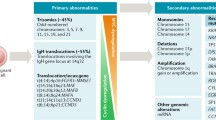Abstract
Myeloma colonies (MY-CFUc) could be grown in vitro for 6 months (median time) after a group of 12 myeloma patients had reached complete remission (CR). In a second group of 25 patients MY-CFUc increased in 17/25 and GM-CFUc in 20/25 patients after cyclophosphamide even though 24/25 patients had a partial response to VAMP and one was in CR. These data suggest that cell killing by cyclophosphamide stimulates residual tumour cells into proliferation and adds further support to the idea that myeloma is under some degree of homeostatic control which may be analogous to that in normal bone marrow. Although lymphoplasmacytoid myeloma cells may be more drug resistant than plasmacytoid myeloma cells in vitro, it was not possible to conclude that the emergence of lymphoplasmacytoid cells at relapse was indicative of resistance to further treatment.
Similar content being viewed by others
Author information
Authors and Affiliations
Rights and permissions
About this article
Cite this article
Maitland, J., Millar, B., Bell, J. et al. Evidence that multiple myeloma may be regulated by homeostatic control mechanisms: correlation of changes in the number of clonogenic myeloma cells in vitro with clinical response. Br J Cancer 61, 429–433 (1990). https://doi.org/10.1038/bjc.1990.94
Issue Date:
DOI: https://doi.org/10.1038/bjc.1990.94
- Springer Nature Limited




